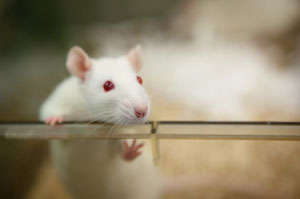NIDA-funded researchers have made the first map of the intrinsic functional organization of the rat brain. To achieve the milestone, Drs. Zhifeng Liang, Jean King, and Nanyin Zhang of the University of Massachusetts Medical School in Worcester surmounted a technical obstacle to imaging neural networks in rodents. Their findings pave the way for animal studies to shed light on the role of functional networks in human health and disease.

Scientists have long possessed detailed maps of the neuron fibers that connect the various regions of the brain, but it is only lately that they have been able to study how these regions coordinate their activity. The enabling technology is functional magnetic resonance imaging (fMRI), which can disclose regional and interregional patterns of neuronal activation and their combination into networks. Among these functional networks, scientists regard as particularly important those that are intrinsic, or detectable when an animal—or person—is awake and alert but not engaged in any directed activity. These networks comprise the fundamental baseline organization of the brain. Studies have correlated intrinsic functional network characteristics with age, gender, and health and disease states, including vulnerability to nicotine dependence and mental illness (see “Resting Brain Studies Shed New Light on Vulnerabilities”).
A major technical obstacle to mapping intrinsic networks in rats has been the difficulty of keeping animals still enough to obtain clear images. Anesthesia is not an option because anesthetic drugs change brain activity. The Worcester researchers acclimated their animals to head and body restraints and to the fMRI environment in several mock imaging sessions. In the actual imaging session, they administered a short-acting anesthetic, placed the animals in the fMRI machine, and made scans after the anesthesia wore off.
In their analyses of the scans, the team identified 38 discrete functional areas throughout the rat brain and examined their interactions. The results disclosed that two important organizational principles that characterize the human brain also govern the rat brain. One, “small-worldness,” promotes efficient communication within local regions through dense communicating pathways and among more distant regions through more direct, less-dense pathways. The other principle, modularity, divides the brain into semi-independent, high-level networks that carry out separate general functions. Thus, in the rat as in the human, discrete modules seemingly serve communication across the cortex, processing of sensory input, and processing of emotion.
The team’s success in obtaining clear images indicates that it is feasible to investigate the impact of invasive procedures, drugs, or genetic manipulation on animals’ intrinsic functional networks. The similarities between rat and human resting-state networks imply that such research may yield insights that are applicable to human brain function and, thus, clinically useful.
Journal of Neuroscience 31(10):3776–3783, 2011. Abstract Available
